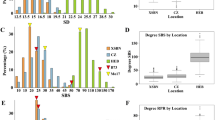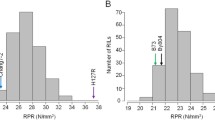Abstract
Maize (Zea mays L.) stalk lodging is breakage of the stalk at or below the ear, which may result in loss of the ear at harvest. Stalk lodging is often intensified by the stalk tunneling action of the second-generation of the European corn borer (2-ECB) [Ostrinia nubilalis (Hübner)]. Rind penetrometer resistance (RPR) has been used to measure stalk strength and improve stalk lodging resistance, and quantitative trait loci (QTL) have been identified for both RPR and 2-ECB damage. Phenotypic recurrent selection (PS) increases the frequency of favorable alleles over cycles of selection. Several studies have indicated that marker-assisted selection (MAS) is also a potentially valuable selection tool. The objective of this study was to compare the efficiency of PS versus MAS for RPR and 2-ECB. Marker-assisted selection for high and low RPR was effective in the three populations studied. Phenotypic selection for both high and low RPR was more effective than MAS in two of the populations. However, in a third population, MAS for high RPR using QTL effects from the same population was more effective than PS, and using QTL effects from a separate population was just as effective as PS. Marker-assisted selection for resistance and susceptibility to 2-ECB using QTL effects from the same population was effective in increasing susceptibility, but not in increasing resistance. Marker-assisted selection using QTL effects from a separate population was effective in both directions of selection. Thus, MAS was effective in selecting for both resistance and susceptibility to 2-ECB. These results demonstrated that MAS can be an effective selection tool for both RPR and 2-ECB resistance. These results also validate the locations and effects of QTL for RPR and 2-ECB resistance identified in earlier studies.





Similar content being viewed by others
References
Alsirt A (1993) Evaluation of frequency distribution changes resulting from bi-directional selection for rind penetrometer resistance in maize. Thesis, University of Missouri
Barry BD, Antonio AQ, Darrah LL (1995) Registration of Mo45, Mo46, and Mo47 maize germplasm lines with resistance to European corn borer. Crop Sci 35:1232–1233
Basten CJ, Weir BS, Zeng Z-B (1994) Zmap-a QTL cartographer. In: Smith C, Gavora JS, Benkel B, Chesnais J, Fairfull W, Gibson JP, Kennedy BW, Burnside EB (eds) Proc 5th World Congress on Genetics Applied to Livestock Production: Computing Strategies and Software. Vol. 22. Organizing Committee, 5th World Congress on Genetics Applied to Livestock Production, Guelph, Ontario, pp 65–66
Basten CJ, Weir BS, Zeng Z-B (2000) QTL Cartographer, Version 1.14. Department of Statistics, North Carolina State University, Raleigh, NC
Cardinal AJ, Lee M, Sharopova N, Woodman-Clikeman W, Long MJ (2001) Genetic mapping and analysis of quantitative trait loci for resistance to stalk tunneling by the European corn borer in maize. Crop Sci 41:835–845
Chesang-Chumo J (1993) Direct and correlated responses to divergent selection for rind penetrometer resistance in MoSCSSS maize synthetic. Dissertation, University of Missouri
Dudley JW (1994) Selection for rind puncture resistance in 2 maize populations. Crop Sci 34:1458–1460
Flint-Garcia SA (2001) Genetic analysis of stalk strength in maize. Dissertation, University of Missouri
Flint-Garcia SA, Jampatong C, Darrah LL, McMullen MD (2003) Quantitative trait locus analysis of stalk strength in four maize populations. Crop Sci 43:13–22
Hallauer AR (1992) Recurrent selection in maize. Plant Breed Rev 9:115–179
Han F, Romagosa I, Ullrich SE, Jones BL, Hayes PM, Wesenberg DM (1997) Molecular marker-assisted selection for malting quality traits in barley. Mol Breed 3:427–437
Hondroyianni E, Papakosta DK, Gagianas AA, Tsatsarelis KA (2000) Corn stalk traits related to lodging resistance in two soils of differing salinity. Maydica 45:125–133
Jampatong C (1999a) Quantitative trait loci for first- and second-generation European corn borer resistance in maize. Dissertation, University of Missouri
Jampatong C, McMullen MD, Barry BD, Darrah LL, Byrne PF, Kross H (2002) Quantitative trait loci for first- and second-generation European corn borer resistance derived from the maize inbred Mo47. Crop Sci 42:584–593
Jampatong S (1999b) Effect of one- and two-eared selection on stalk strength and other characters in maize. Dissertation, University of Missouri
Kang MS, Din AK, Zhang YD, Magari R (1999) Combining ability for rind puncture resistance in maize. Crop Sci 39:368–371
Kumar, LS (1999) DNA markers in plant improvement: an overview. Biotechnol Adv 17:143–182
Lande R, Thompson R (1990) Efficiency of marker-assisted selection in the improvement of quantitative traits. Genetics 124:743–756
Lawson DM, Lunde C, Mutschler MA (1997) Marker-assisted transfer of acylsugar-mediated pest resistance from the wild tomato, Lycopersicon pennellii, to the cultivated tomato, Lycopersicon esculentum. Mol Breed 3:307–317.
Lin HX, Yamamoto T, Sasaki T, Yano M. (2000) Characterization and detection of epistatic interactions of 3 QTLs, Hd1, Hd2, and Hd3, controlling heading date in rice using nearly isogenic lines. Theor Appl Genet 101:1021–1028
Mason CE, Rice ME, Calvin DD, VanDuyn JW, Showers WB, Hutchinson WD, Witkowski JF, Higgins RA, Onstad DW, Dively GP (1996) European corn borer ecology and management. NCR Pub No 327, Iowa State University Press, Ames, Iowa
McDevitt CM (1999) Responses to three cycles of selection with a clamp for plant standability in two maize populations. Thesis, University of Missouri
Romagosa I, Han F, Ullrich SE, Hayes PM, Wesenberg DM (1999) Verification of yield QTL through realized molecular marker-assisted selection responses in a barley cross. Mol Breed 5:143–152
SAS Institute, Inc (1998) SAS proprietary software version 7 (TS P1). SAS Institute, Cary, NC
Scheider KA, Brothers ME, Kelly JD (1997) Marker-assisted selection to improve drought tolerance in common bean. Crop Sci 37:51–60
Sibale EM, Darrah LL, Zuber MS (1992) Comparison of two rind penetrometers for measurement of stalk strength in maize. Maydica 37:111–114
Spiess JE (1995) Evaluation of selection progress in three dent corn x popcorn populations. Thesis, University of Missouri
Stuber CW (1994) Breeding multigenic traits. In: Phillips RL, Vasil IK (eds) DNA-based markers in plants. Kluwer, Dordrecht, pp 58–96
Stuber CW, Edwards MD (1986) Genotypic selection for improvement of quantitative traits in corn using molecular marker loci. In: Proc 41st Annual Corn and Sorghum Industry Research Conf., vol 41. American Seed Trade Assoc, Washington, DC, pp 70–83
Van Berloo R, Stam P (1999) Comparison between marker-assisted selection and phenotypical selection in a set of Arabidopsis thaliana recombinant inbred lines. Theor Appl Genet 98:113–118
Wilcox MC, Khairallah MM, Bergvinson D, Crossa J, Deutsch JA, Emeades GO, González-de-León D, Jiang C, Jewell DC, Mihm JA, Williams WP, Hoisington D (2002) Selection for resistance to Southwestern corn borer using marker -assisted selection and conventional backcrossing. Crop Sci 42:1516–1528
Yamamoto T, Kuboki T, Lin SY, Sasaki T, Yano M. 1998. Fine mapping of quantitative trait loci Hd-1, Hd-2 and Hd-3, controlling heading date of rice, as single Mendelian factors. Theor Appl Genet 97:37–44
Yousef GG, Juvik JA (2001) Comparison of phenotypic and marker-assisted selection for quantitative traits in sweet corn. Crop Sci 41:645–655
Acknowledgements
The authors acknowledge Arturo Garcia, Sheri Martin, Arnulfo Antonio, Charles Thiel, Tim Praiswater, and Julie Barry for their assistance in phenotypic data collection. S. Flint-Garcia was supported by the Maize Biology Training Grant, NSF BIR 9420688, and the University of Missouri M.S. Zuber Assistantship Endowment. Research support was provided by the Plant Genetics Research Unit, USDA-ARS.
Author information
Authors and Affiliations
Corresponding author
Additional information
Communicated by D. Hoisington
Rights and permissions
About this article
Cite this article
Flint-Garcia, S.A., Darrah, L.L., McMullen, M.D. et al. Phenotypic versus marker-assisted selection for stalk strength and second-generation European corn borer resistance in maize. Theor Appl Genet 107, 1331–1336 (2003). https://doi.org/10.1007/s00122-003-1387-9
Received:
Accepted:
Published:
Issue Date:
DOI: https://doi.org/10.1007/s00122-003-1387-9




